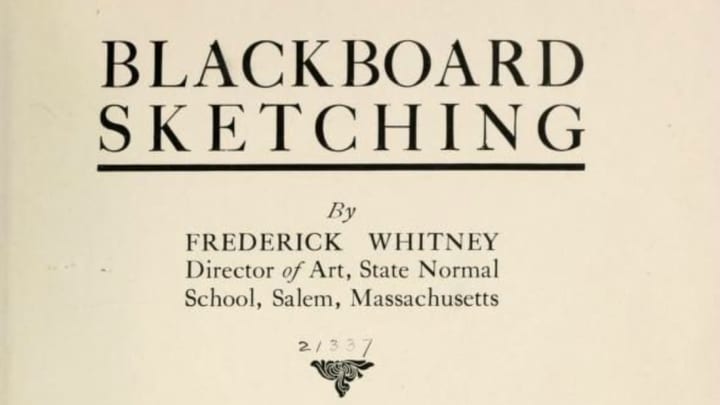Sometimes, the act of teaching is a work of art. In the days before clip art and Google image search, artistically-challenged teachers had few alternatives to the chalkboard for their visual-based lessons. Enter Frederik Whitney, author of Blackboard Sketching, who wrote his guide in 1909 with the promise that, with a few basic strokes and some practice, anybody could turn a chalkboard into a canvas. Check out the virtual art gallery below of chalk art that’s too good for the sidewalk.
1. Plate 1

Whitney starts his lesson with a basic stroke and steps for drawing a telegraph pole and a chicken coop. “Ability to draw easily and well onto blackboard is a power which every teacher of children covets,” art educator Walter Sargent writes in the introduction. “Such drawing is a language which never fails to hold attention and awaken delighted interest.”
2. Plate 2

The secret to many of Whitney’s drawings is to use the round side of chalk rather than the flat end. He advises that in order to create a gradient line, you should hold your chalk on one end, and when you’re ready, put pressure on the end instead of the middle for a shaded look.
3. Plate 3

How do you like them apples? Once a teacher masters the rounded fruit, Whitney suggests he or she try the following activity with the class: draw a bunch of apples, each printed with a different word. As the students are able to identify a word on the apple, it is erased.
4. Plate 5

Especially festive educators may feel the need to decorate depending on the season. Whitney suggests using a pumpkin for the month of October.
5. Plate 7

This sketch of a mountain is the first in a series of images that he advises using when teaching geography. “The teacher who, with a few strokes of the chalk, can interpret to her class the thing about which they are studying, and can make an illustration which the whole class can see and appreciate, has an invaluable gift,” he writes.
6. Plate 8

Whitney’s sketch of a teepee combines the four techniques he has explained so far in his book.
7. Plate 10

Whitney suggests a second reading game once you master the art of drawing a ladder: write vocabulary words on each rung of the ladder and let students see how far they can “climb” by identifying each word.
8. Plate 12

This lesson focuses only on the ability to draw trees. “In sketching trees,” Whitney writes, “one should bear in mind the general attitude of the tree, its characteristic form and branching, and the stroke which will best produce these.”
9. Plate 14

Whitney breaks down which strokes should be used to create each aspect of his fireplace drawing. To make the fire in the fireplace, create a circle of white chalk, then smear it with your fingertip to create a smoky effect.
10. Plate 16

Whitney suggests using this image during a history lesson about the type of houses used by the early settlers. He writes that the log cabin pictured above is supposed to be the birthplace of Abraham Lincoln.
11. Plate 17

This is a favorite among students. “Whenever I have made a sketch of this kind it has always given great pleasure to the children, and proved of more or less value in history, or in story-telling in the lower grades,” Whitney writes.
12. Plate 23

Whitney uses charcoal to add details to the feathers in this bird sketch. To ensure your bird pops, rub some white chalk into the background to create a light gray on the board.
13. Plate 25

Whitney created this illustration for use with studies of the poem “Flower-de-luce” by Henry Wadsworth Longfellow, demonstrating how blackboard sketching can be appreciated by students of all ages, no matter the subject matter.
14. Plate 26

This eerie castle sketch includes a quote from William Shakespeare’s Macbeth, and would serve as a stunning backdrop to any discussion of the classic tragedy.
15. Plate 29

Whitney notes that this image was hastily sketched by the teacher, as if there's nothing to it. “Any teacher can easily arrange such backgrounds and costumes with the simplest material at hand, and in this manner add essentially to the interest and value of a lesson,” he remarks.
